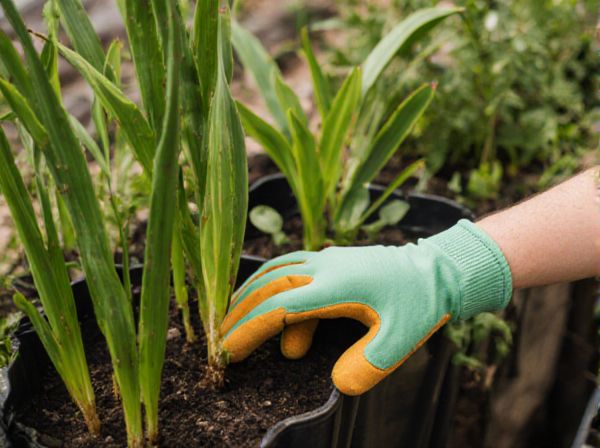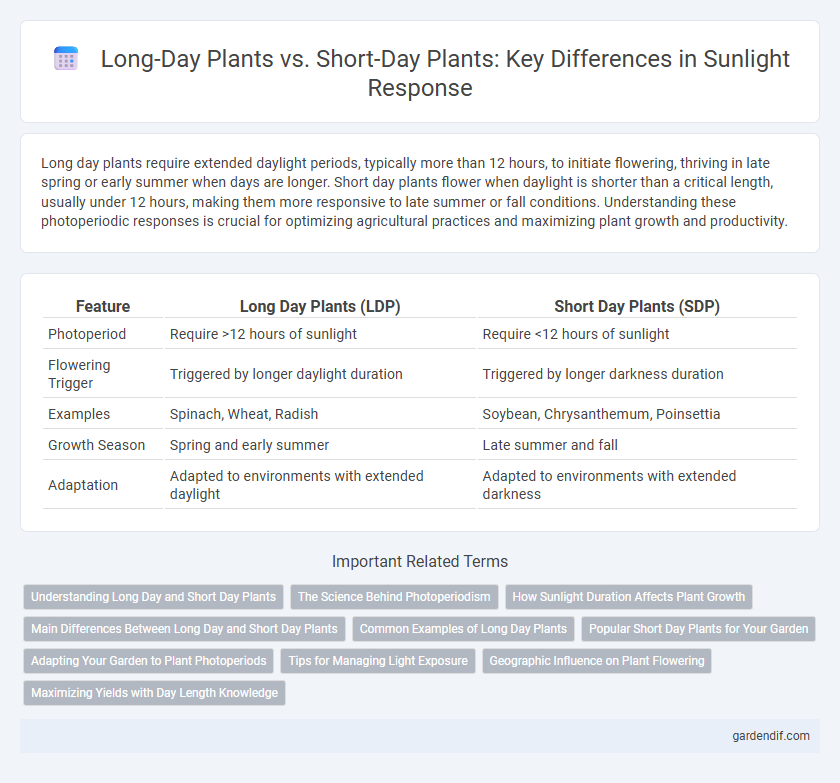
Long Day Plants vs Short Day Plants Illustration
Long day plants require extended daylight periods, typically more than 12 hours, to initiate flowering, thriving in late spring or early summer when days are longer. Short day plants flower when daylight is shorter than a critical length, usually under 12 hours, making them more responsive to late summer or fall conditions. Understanding these photoperiodic responses is crucial for optimizing agricultural practices and maximizing plant growth and productivity.
Table of Comparison
| Feature | Long Day Plants (LDP) | Short Day Plants (SDP) |
|---|---|---|
| Photoperiod | Require >12 hours of sunlight | Require <12 hours of sunlight |
| Flowering Trigger | Triggered by longer daylight duration | Triggered by longer darkness duration |
| Examples | Spinach, Wheat, Radish | Soybean, Chrysanthemum, Poinsettia |
| Growth Season | Spring and early summer | Late summer and fall |
| Adaptation | Adapted to environments with extended daylight | Adapted to environments with extended darkness |
Understanding Long Day and Short Day Plants
Long day plants require more than 12 hours of sunlight to initiate flowering, thriving in extended daylight conditions typically found in late spring and early summer. Short day plants bloom when daylight lasts fewer than 12 hours, relying on longer nights to trigger their flowering cycle, common in late summer and fall. Understanding the photoperiod sensitivity of these plants is crucial for optimizing growth and ensuring successful flowering in varied climates.
The Science Behind Photoperiodism
Long day plants require more than 12 hours of uninterrupted darkness to trigger flowering, relying on extended daylight periods to regulate their growth through photoperiodism. Short day plants initiate flowering when exposed to fewer than 12 hours of light, using the phytochrome system to measure night length and activate flowering genes. Photoperiodism, controlled by the plant's biological clock and light receptors, governs these responses to ensure optimal timing for reproduction and survival.
How Sunlight Duration Affects Plant Growth
Long day plants require extended periods of sunlight, typically more than 12 hours, to trigger flowering, making them thrive during the longer days of spring and summer. Short day plants initiate flowering when daylight falls below a critical threshold, usually less than 12 hours, adapting to shorter days in late summer or fall. The duration of sunlight directly influences the hormonal signals in plants, regulating growth phases such as vegetative development and reproductive blooming.
Main Differences Between Long Day and Short Day Plants
Long day plants require more than 12 hours of uninterrupted sunlight to flower, while short day plants bloom when daylight is less than 12 hours. Long day plants rely on extended daylight periods to initiate flowering, whereas short day plants depend on longer nights for floral development. These photoperiodic responses regulate their growth cycles and seasonal adaptations.
Common Examples of Long Day Plants
Long day plants thrive when daylight exceeds 12 hours, triggering flowering in species such as spinach, lettuce, clover, and wheat. These plants typically bloom in late spring or early summer, utilizing extended sunlight to maximize photosynthesis and growth. Understanding the photoperiodic response of long day plants aids in optimizing agricultural planning and crop yield.
Popular Short Day Plants for Your Garden
Popular short day plants for your garden include chrysanthemums, poinsettias, and soybeans, which require less than 12 hours of daylight to initiate flowering. These plants thrive in environments with extended periods of darkness during the day, making them ideal for autumn and winter gardening. Understanding the photoperiodic needs of these crops helps optimize bloom time and yield in home or commercial gardens.
Adapting Your Garden to Plant Photoperiods
Long day plants require more than 12 hours of sunlight daily to trigger flowering, thriving in late spring and summer conditions when daylight extends. Short day plants bloom when daylight falls below 12 hours, making autumn and early spring ideal for their growth cycles. Adjusting garden layouts and selecting species based on regional photoperiods ensures optimal flowering and productivity by aligning planting schedules with natural sunlight durations.
Tips for Managing Light Exposure
Long day plants require more than 12 hours of sunlight to flower optimally, so ensuring they receive extended natural or supplemental light is crucial for growth. Short day plants need less than 12 hours of light and benefit from controlled darkness periods to trigger flowering, making blackout curtains or timed lighting systems effective management tools. Monitoring photoperiods with light sensors and adjusting exposure precisely can optimize plant health and maximize yield for both types of plants.
Geographic Influence on Plant Flowering
Long day plants flower when daylight exceeds a critical duration, commonly found in higher latitudes where summer days are extended, such as northern Europe and Canada. Short day plants bloom when daylight falls below a threshold, typically thriving in tropical and subtropical regions near the equator with relatively consistent day lengths. Geographic latitude directly influences the photoperiod, thereby determining the flowering cycles of these plants based on regional sunlight exposure patterns.
Maximizing Yields with Day Length Knowledge
Long day plants, such as spinach and lettuce, require more than 14 hours of sunlight to flower and maximize growth, making extended exposure to natural or artificial light essential for optimizing yields. Short day plants, including chrysanthemums and soybeans, flower when daylight decreases below 12 hours, so understanding their photoperiodic needs ensures timely flowering and higher productivity. Farmers and horticulturists can maximize crop yields by accurately managing light durations based on each plant's critical day length for optimal photosynthesis and developmental transitions.
Long Day Plants vs Short Day Plants Infographic

 gardendif.com
gardendif.com